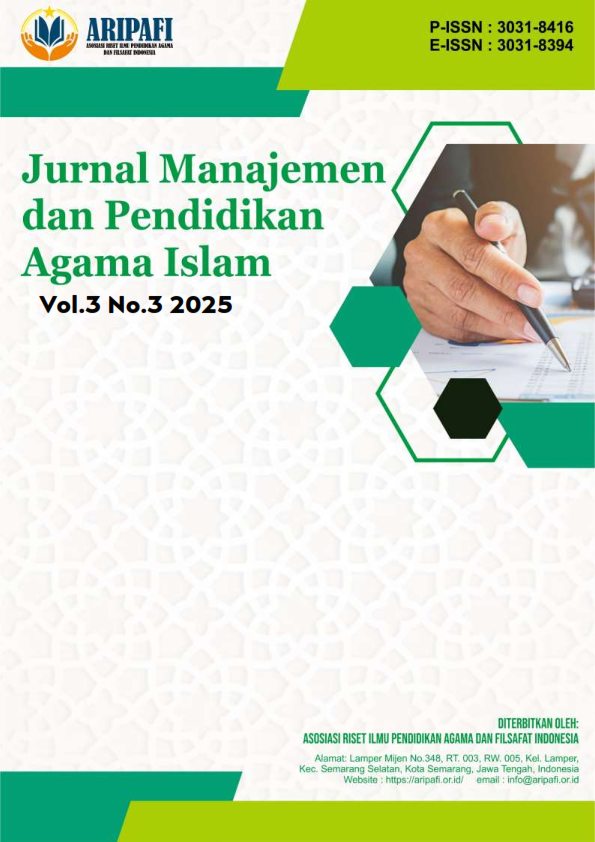Implementasi Penggunaan Turutan Sebagai Alternatif Belajar Membaca Al-Qur’an Bagi Pemula
(Studi Kasus di Madin Al-Farabi, Cabean Kota Salatiga)
DOI:
https://doi.org/10.61132/jmpai.v3i3.1053Keywords:
Baghdadiyah, Method, SequenceAbstract
This article discusses applying the Baghdadiyah method using the Turutan book as an alternative teaching approach for beginners learning to read the Qur'an at Madrasah Diniyah Al-Farabi, Cabean, Salatiga City. The Qur'an is a holy book, and one must understand and be well-versed in the correct tajweed rules. The Baghdadiyah method, also known as the sequence method, was chosen to improve students' reading skills. This study employed a qualitative field research approach to observe the teaching and learning environment at Madrasah Diniyah Al-Farabi. The research findings indicate that although many students find it challenging to learn the Qur'an, this method helps students comprehend hijaiyah letters and tajweed. The advantages of this method include its clear structure and ease of use, though it does have some drawbacks, such as requiring intense focus and pressure for memorization. Nonetheless, the method is considered effective for beginners in learning the Qur'an.
Downloads
References
Abror, I. (2022). Metode pembelajaran Al-Qur’an: Kumpulan metode-metode belajar huruf Al-Qur’an. Yogyakarta: SUKA-Press.
Amri, H. (2020). Implementasi metode Al-Baghdadi dalam meningkatkan kemampuan membaca Al-Qur’an di TPA Al-Khairiyah Desa Putihdoh Kecamatan Cukuhbalak Kabupaten Tanggamus Lampung. UIN Raden Intan Lampung.
Asfahani, & Hajar, I. (2023). Efektifitas metode Baghdadiyah dalam pembelajaran membaca Al-Qur’an siswa SMP. Global Education Journal, 1(01), 15–26. https://doi.org/10.59525/gej.v1i1.137
Hadinata, S. (2021). Implementasi pembelajaran Al-Qur’an dengan metode Ummi terhadap kemampuan membaca Al-Qur’an bagi anak usia 7-13 tahun di Desa Teniga Kecamatan Tanjung Kabupaten Lombok Utara. Ta’dib: Jurnal Pendidikan Islam dan Isu-isu Sosial, 19(1), 60–79. https://doi.org/10.37216/tadib.v19i1.423
Hamdani, M. (2018). Penerapan metode membaca Al-Qur’an pada TPA di Kecamatan Amuntai Utara (Studi pada metode Iqra dan metode Tilawati). Al Qalam: Jurnal Ilmiah Keagamaan dan Kemasyarakatan. https://doi.org/10.35931/aq.v0i0.12
Kasmar, I. F., & Anwar, F. (2021). Metode guru dalam mengatasi kesulitan belajar Al-Qur’an peserta didik. An-Nuha, 1(4), 617–629. https://doi.org/10.24036/annuha.v1i4.140
Kusuma, Y. (2018). Model-model perkembangan pembelajaran BTQ di TPQ/TPA di Indonesia. J-PAI: Jurnal Pendidikan Agama Islam, 5(1). https://doi.org/10.18860/jpai.v5i1.6520
Latifah, U., & Amirudin, N. (2024). Implementasi metode Qiroati dalam pembelajaran Al-Qur’an. Jurnal Pendidikan Islam Al-Ilmi, 7(1), 20–28. https://doi.org/10.32529/al-ilmi.v7i1.2956
Muhammedi, M. (2018). Metode Al Baghdadiyah (Metode pembelajaran yang efektif dalam menanamkan sikap religius siswa dan meningkatkan hasil belajar pendidikan agama Islam). Al-Fatih: Jurnal Pendidikan dan Keislaman, 1(1), 96–122. https://doi.org/10.30821/alfatih.v1i1.6
Nasution, S. (1972). Didaktik azas-azas mengajar. Bandung: Jemmars.
Downloads
Published
How to Cite
Issue
Section
License
Copyright (c) 2025 Jurnal Manajemen dan Pendidikan Agama Islam

This work is licensed under a Creative Commons Attribution-ShareAlike 4.0 International License.





